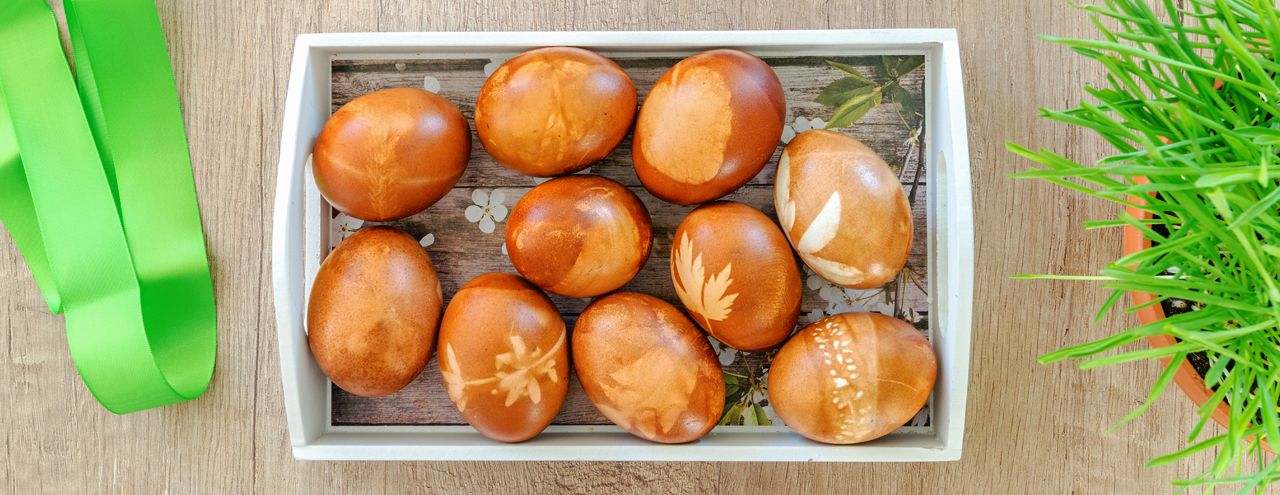What are the most popular topics around Easter? How to dye eggs, how to decorate the home for Easter, what to cook, how to entertain kids, right? Since you can find tons of detailed tips for these topics elsewhere, we’ll just briefly share with you a few of our personal favorites:
Onion Dyed Eggs:
In Greek Orthodox tradition there’s a cool trick for dying Easter eggs using onions. You’ll also need some small herbs (leaves of grass, clover, dandelion, or any similar plant you find in your garden), pair of lady stockings and some ribbon or rubber band.
Prepare the eggs by spreading an herb over a side of an eggshell, so that it will leave a trace nicely, and wrap a piece of stocking around the egg tightly, tying the ends with a ribbon or rubber band. Once you do the same thing with all the eggs, put them in water with onion skins, and start cooking.
Don’t turn the heat up too much, because you don’t want the eggs to crack. Simmer for 15-20 minutes, then cut the stockings to take the eggs out, remove all herbs, and let the eggs cool completely.
The eggs will have a deep red color and a beautiful herbal pattern. You can also take a piece of cotton, put some oil on, and use it to coat each egg for additional shine.
Easter Egg Hunt:
If the weather is nice and you have a garden, the best way to spend Easter is to get your kids and some of their friends together for Easter barbecue at your home. Before they arrive, you’ll have hidden colorful eggs throughout the garden. Don’t be soft on the kids – make sure they really make an effort to find all the eggs. Be resourceful; you don’t want to place all eggs on the ground. You’ll see why later in the text.
While the kids are busy searching, you can catch up with the kids’ parents over a glass of wine/beer.
The Easter egg hunt is supposedly a Protestant tradition, introduced by the reformer Martin Luther whose men also hid eggs for women and children to look for and have fun. Their belief was that the Easter egg symbolized the tomb from which Christ had resurrected.
Where Are Those Promised Safety Tips?
Ah, yes. When Easter comes, most of us think about how to spend quality time with our family. Not many of us are concerned that there are some safety risks involved with the tradition. The risks are actually not connected to Easter, but to the consumption of eggs, which are the core of Easter celebration.
The USDA website has useful recommendations for this particular holiday. We believe they are very reasonable and all egg consumers should be aware of these tips 365 days of the year, not just on Easter. But we’re using the occasion to spread the word, so here they are:
7 Tips for Risk-Free Easter Egg Consumption
- Wash your hands before dying the eggs.
- Make sure you cook the eggs thoroughly until they are hard-hard boiled.
- Use only food-safe coloring for your eggs. (Onion skin is definitely safe.)
- After dying the eggs, don’t keep them out of the refrigerator for longer than 2 hours. (So, that’s the longest you can have your kids search for the eggs.)
- Don’t eat eggs that have been lying on the ground and have cracked, because they are potentially contaminated with bacteria.
- Uncracked eggs used for egg hunt should be washed before consumption.
- After refrigerating the eggs, eat them within 7 days of cooking.
Bonus non-safety tip: If you’re struggling to find the time for egg decoration, here’s the fastest way to do it. Simply place our free Easter stickers on boiled eggs! The stickers are so cute, no one will notice the eggs are not dyed.
Have a wonderful (and safe!) Easter!

